| [7]
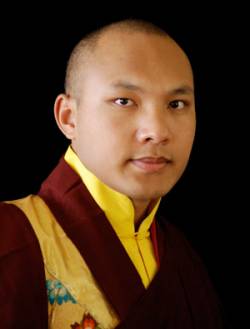
His Holiness the Gyalwa Karmapa, Ogyen Trinley Dorje
as told by Venerable Chöje Lama Phuntsok Rinpoche
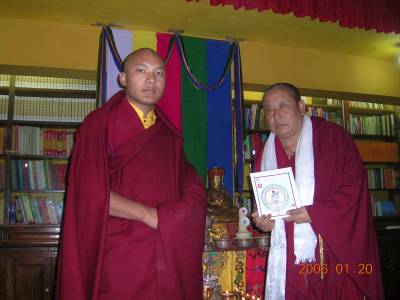
I want to greet you kindly and wish to speak about the Lineage of the Karmapas, especially seeing that it’s very important to know that any practice one does depends upon the blessings of one’s Lama, which, in turn, depends upon oneself. “Lama” is a general term, but when we speak about Lama, we mean His Holiness the Gyalwa Karmapa.
The Lineage of the Victorious Karmapas was founded by Karmapa Düsum Khyenpa, the First Gyalwa Karmapa (1110–1193 CE). The name of the Sixteenth in succession of the Karmapas was Rangjung Rigpe Dorje. Many people living today met the Sixteenth Gyalwa Karmapa and say that they never experienced another Lama who was as realized as he. The Sixteenth Gyalwa Karmapa knew the three times, because nothing impeded his clear vision. All Karmapas know the three times (the past, present, and future), although this name was only given to the First Karmapa, Düsum Khyenpa, which means “Knower of the three times.”
When His Holiness the Sixteenth Karmapa was seventeen years old, he was residing at Palpung Chökhor Ling Monastery in Tibet together with the Eleventh Situ Rinpoche, Pema Wangchuk (1886-1952), the former incarnation of the present Twelfth Situ Rinpoche. At that time, the Karmapa prophesied the future in the form of a song by using many words.
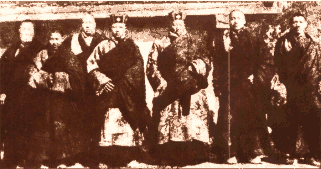
The Song of His Holiness the Sixteenth Gyalwa Karmapa
“This song is ala thala thala.
Ala is the way it arose. Thala is the way it is expressed in words.
In a pure land, rich with turquoise leaves,
On a throne of brilliant, white shell is the deity of long life, the mother Lady Tara.
I pray to her from the depths of my heart.
May there be no obstacles to long life.
If you do not recognize this place, it is the Retreat House of Palpung.
If you do not recognize a person like me,
There is the upper valley of delight Shukra
And the lower valley of delight Shukra; in the place between the two Shukras
Is a child who descends from Tshazhang Denma.
If you call him by name, it is Thubten Gelek.
Not now but on a distant tomorrow it will be decided.
Both the vulture and I know where to go. The vulture soars into the expanse of the sky;
Our people do not stay, but go to India.
In the springtime, a cuckoo comes as a guest.
In the fall when the harvest ripens, it knows where to go. Its only thought is travel to east of India.
In the lofty land of Tibet, the inhabitants, high and low,
And in particular, you, Tai Situ, the Lord and Protector Maitreya,
Who remains above the crown of our head, may your activities, like the sun and moon set in space,
Be continuous, stable, and without hindrance.
I pray that we meet again and again. May the three roots – the Lama, yidams, and dakinis –
protect him from negative conditions and obstacles.
Keep the precise meaning recorded here in the depth of your heart.”
The metaphor in The Song, “the vulture soars into the expanse of the sky,” points to the fact that Situ Pema Wangchuk would die soon. His Holiness furthermore prophesied that he and his people - all monks, nuns, and lay practitioners – would be robbed of their freedom in Tibet, would have to leave their homeland and flee the only possible way, which would be to East India and Sikkim. The prophecy came true. Tibet was robbed of its independence in 1959 and His Holiness the Fourteenth Dalai Lama, His Holiness the Karmapa, and many, many Tibetan Lamas were forced to flee from their own country. They were generously offered asylum in India as well as in the adjoining Himalayan Kingdoms.
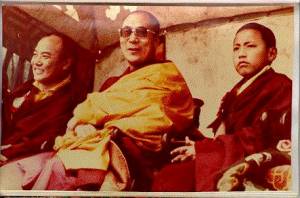
His Holiness the Karmapa’s rigs-bdag, “Lord of the family” (which actually means “Root Guru”), is Tai Situ Rinpoche, and in The Song the Karmapa prayed always to be together with him. This doesn’t mean to say that he wanted to be together with him every day of the year, rather he prayed that they always meet in future lives. After the Paranirvana of the Sixteenth Karmapa, he reincarnated as the Seventeenth and again met his Root Guru. And so we see
that the entire prophecy that the Sixteenth Gyalwa Karmapa made in The Song came true.
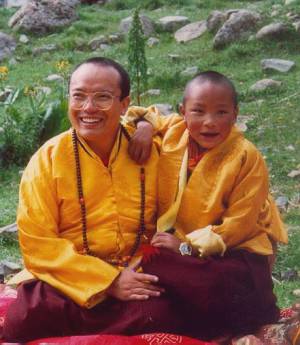
The Gyalwa Karmapa appears for the welfare and benefit of all living beings and manifests his wondrous activities according to each individual’s needs and capacities. There were no Buddhist centres in the West little to more than thirty years ago. A few Lamas travelled abroad, but devotees were very preoccupied with daily obligations and therefore didn’t have much time. The Sixteenth Karmapa set out on his first world tour in 1974. He took a second tour in 1977 and coined the new Tibetan word phyir-tshogs, which means “Dharma centre abroad” when he founded the first centres in the West. And now there are thousands of Dharma centres in Europe, America, and East Asia. The great number of Dharma centres in the world, the many people who have become Buddhists and practice the Dharma by training their minds and realizing its nature are due to the immeasurable activities of the Gyalwa Karmapa. Just thinking about the deep and vast activities of the Glorious Karmapa, the fact that there are many Dharma centres, that people living in all nations receive and are able to practice the precious teachings is truly wonderful and marvellous.
People in the East are benefiting immensely ever since Buddhism has been established in the West and is becoming more central and decisive in the lives of very many westerners. In the past, it was a bit embarrassing to be seen on the streets in India and Nepal counting mantras on one’s mala – people looked at us as though we were quaint and old-fashioned when we recited mantras in public. Not any more, seeing westerners are practicing the Dharma and are also reciting mantras freely and openly. Indians and Nepalis notice this and are starting to practice too. In the meantime, many western and Tibetan Buddhists have become scholars or very knowledgeable and as a result help spread the Buddhadharma. Whose inspiration and influence is this? The Gyalwa Karmapa’s. Taking the wondrous activities of the Gyalwa Karmapa to mind, unwavering trust and devotion arise in us.
After the first Tibetan refugees arrived in India and Nepal in the 50’s and 60’s, a few Geshes were able to flee to the West in 1963 or 64. They had to work for their living, were able to do a lot by integrating in the respective societies they lived in, for example, by marrying and having children. You know how many Dharma centres there are in Germany now and are informed about what is available to you. The Karmapa has done this for us.
Who do we turn to now that the Sixteenth Karmapa is not among us anymore? He has returned as the Seventeenth Gyalwa Karmapa. His name is Ogyen Trinley Dorje, but in truth he is the Karmapa. The life-story of the Karmapa, who is still very young, is already more than amazing.
When reciting the sacred mantra of His Holiness - “Karmapa Khyenno” - it will be very beneficial to imagine him in his first manifestation as Düsum Khyenpa, “Knower of the three times,” to visualize all incarnations, until he appeared as the Sixteenth Karmapa, Rangjung Rigpe Dorje, and now to visualize him as the Seventeenth Karmapa. Making the wishing-prayers to see him, to meet him, and to have the chance to speak with him is already an immense blessing.
The name of His Holiness, Ogyen Trinley Dorje, was not given to him randomly by a Lama, rather his name was prophesied by Guru Rinpoche in a gter-ma, a treasure-text. Chögyur Dechen Lingpa, also known as Shikpo Lingpa (1829-1870 CE), was a treasure-revealer, a gter-stön, who was together with the Karmapa until his fourteenth incarnation and who brought the treasure-text that reveals the name of the Seventeenth Karmapa to light. The title gling-pa is that of a Tertön and literally means “sanctuary of peace and happiness.” Tertön Chögyur Lingpa only perceived pure visions and directly received Guru Rinpoche’s prophecy concerning the Fifteenth Karmapa, Khakhyab Dorje (1871-1922), the Sixteenth Karmapa, Rangjung Rigpe Dorje (1924-1981), and the Seventeenth Karmapa, Ogyen Trinley Dorje, who was born in 1985.
Before passing into Paranirvana, the Sixteenth Karmapa prophesied that he would take birth north of India, which only points to Tibet. He wrote down in which area of Tibet he would take birth, namely in the east, described the environment clearly, and also wrote down the name of his father and mother. He wrapped the letter of recognition in a srung-ma, a protective amulet, gave it to his Eminence Situ Rinpoche, and told him that he would need the amulet in the future. The Seventeenth Karmapa was found in reliance upon this letter of recognition.
In a vision, His Holiness the Fourteenth Dalai Lama also saw that the Karmapa would take birth in East Tibet and recognized the incarnation as that of the Sixteenth Karmapa. His Holinesss the Karmapa was brought to Tsurphu Monastery. In accordance with the prophecy made by Guru Rinpoche, he was given the name Ogyen Trinley Dorje by His Eminences Tai Situ and Goshir Gyaltsap Rinpoche.
The Chinese government officially recognized the incarnation of the Karmapa and sent a representative to Tsurphu Monastery to confirm this in a written statement, which is really amazing. The Chinese are communists, don’t have a spiritual belief, and don’t like spiritual people, so it’s really exceptional that they documented their recognition of a reincarnate Lama. This was the only point His Holiness and the Chinese government agreed on, otherwise they never got along and couldn’t come to agreements on any other matter except this one, which again shows how majestic the Karmapa is. Just think of the Panchen Lama: The Chinese reject and deny the incarnation of the Panchen Lama found by His Holiness the Dalai Lama and hold him captured and keep him in strictest custody. So we again see that the Glorious Karmapa doesn’t only carry a title, but manifests incredible activities.
When His Holiness the Seventeenth Karmapa was twelve years old, the Chinese government invited him to Peking. He accepted the invitation and went. When he met with Jiangtse-Min, former president of China (who calls himself “Chairman of the People's Republic of China”), Jiantse-Min told him, “If ever you need anything, I will help you.” His Holiness replied, “Thank you very much. I don’t need anything for myself. But ever since 1959 our universities, monasteries, and libraries are destroyed and most of our books were burned. I know that many of our sacred texts are now being kept in Peking, at Norbu Lingka, and elsewhere. Please help me get hold of them, especially those of the Kagyu School, otherwise I need no help.” Imagine how skilled His Holiness was when, at such a young age, he said this to the Chairman of the People’s Republic of China. No other twelve-year old boy would even think about things like this - they only seem to have motorcycles or airplanes in their heads. Jiantse-Min even gave a written statement to His Holiness that he would make photocopies of the sacred texts and give them to him, which he did. So His Holiness has many copies of texts that are 500 or 600 years old. This is certainly an amazing and wonderful feat.
There was quite a vast collection of literature in the Kagyu School on Sutras, Tantras, and yogic practices during the times of the Sixth, Seventh, Eighth, and Ninth Karmapas (between 1400 and 1600 CE). They became scattered during the times of the Tenth Karmapa. His Holiness the Seventeenth Karmapa has expressed his wish to have these texts again.
His Holiness decided to flee to India when he was thirteen and managed to do so when he was fourteen. Around 60 or 70 Chinese police were constantly guarding the Karmapa at Tsurphu, so he could never go outside the monastery without a guard trailing him. But on December 28 th, 1999, at 11 o’clock at night, he left Tsurphu unnoticed and fled from Tibet via Nepal to Dharamsala in India. Nobody even noticed him while he was on the way, not even the military posts. He arrived in India five days later, on January 3, 2000. It’s almost inconceivable, seeing he had no passport and visa, isn’t it? And now he has been in India for seven years. When one thinks about the activities that His Holiness has manifested, then it is extraordinary. You will see how he is for yourself when he comes to the West in a few years.
Many Christians, Hindus, and Moslems living in India seek advice from the Gyalwa Karmapa and he always teaches them with earnest respect for their beliefs. He has accepted invitations to speak to the Moslem, Hindu, and Sikh communities in India. It doesn’t matter which religion someone belongs to, he takes everyone seriously and always helps him and her. This is another skilful method to pacify conflicts, seeing most wars arise due to differing religious beliefs. Tension between leaders and representatives from various religions diminishes if one enters and cultivates a dialogue with one another. Everyone perceives and experiences outer appearances differently, but they do share similar outer impressions. So this has been a short description of the outer life of the Glorious Karmapa until now. Many wondrous miracles have arisen in the inner life of His Holiness, too.
Only two people knew that His Holiness would leave Tsurphu at 11 o’clock in the night of December 28, 1999. People are usually very nervous and cannot eat or sleep before undertaking something as decisive and dangerous as that, but nobody noticed any change in his demeanour. At 10 o’clock in the night of January 3, 2000, he left his car behind and walked across the border to Nepal. There aren’t police or military posts, no villages or houses either; only a few tradesmen spend the night in their cars there. Even though there was no moonlight, His Holiness the Karmapa noticed that the sky was very clear due to the bright light of the stars. It was a very auspicious night, because the tradesmen felt so much peace, without knowing that the Karmapa was near them. He was able to ease them, because he had no fear. If someone like us were trying to escape, we would be very scared and would tremble with fright, scaring those who are near us. The district in Nepal across the border from Tibet is called Mustang, and His Holiness spent his first night in a village called Nethang.
His Holiness stayed in the home of villagers in Nethang. These people have great faith and devotion in the Karmapa, but they did not know that he spent the night in their little home. He was not wearing robes, but was dressed in simple street clothes, was wearing a fancy gold ring, and had a pack of cigarettes visible in his shirt pocket so that nobody would have the slightest notion that the Karmapa was in their presence. The Karmapa was accompanied by five or six Lamas and monks, and, in order to conceal their identity, the older monk sat down on the thrown and acted as though he was guiding the group, while the Karmapa pretended to be his servant. The humble villagers asked him if he was also a Lama, but he answered, “No, no. I am only a student and am going to my teacher in India.” He asked the host for a blanket and lay down on the floor near what serves as an outhouse inside the cottage. Nevertheless, there were villagers who thought to themselves that he was a Lama, even though he was wearing a gold ring and had cigarettes in his pocket for everyone to see; they suspected that he was a Lama who was protecting himself. The next morning the group left, and the family still did not know that they had given the Karmapa a place to sleep that night.
The group continued walking across the Thorwa Pass to Manang. In winter Manang Valley is covered with thick snow and villagers usually descend to the lowlands to avoid the cold. Few people remain to look after their houses and livestock. The group of refugees spent the next night in a little lodge in Manang. The next morning a helicopter was flown in from Kathmandu and took the Karmapa and the little group to Nagakot near Kathmandu. The Karmapa spent that night in a hotel at Nagakot. His Eminence Sangye Nyenpa Rinpoche was also staying there with a group of students. His Holiness saw His Eminence having a meal in the restaurant, but His Eminence did not recognize him.
The morning after having crossed the border to Nepal, the Gyalwa Karmapa and the group were taken to the Indian border. He crossed into India on January 3, 2000 and immediately went to a hotel in Dharamsala. An employee from the hotel phoned the Office of the Tibetan Government in Exile and told the person who answered the phone that the Karmapa was in town. A representative of the Office of His Holiness the Dalai Lama came to the hotel, was extremely perplexed, and didn’t hesitate to phone His Holiness the Dalai Lama right away. They rushed the Karmapa to the residence of His Holiness the Dalai Lama, without even having time to offer kathaks or make prostrations, that’s how excited and happy they were – as though a mother had found her lost child. On January 5, BBC broadcast the news worldwide that His Holiness the Gyalwa Karmapa had arrived in India.
Chinese representatives from the consulate in Kathmandu had searched for the Karmapa all over Kathmandu since he had left Tsurphu and then heard that he was in India in the news. Before they heard the news, they came to all monasteries and asked thousands of questions again and again, causing us lots of problems for an entire month. Of course, we were not worried, because we didn’t know anything, but they did pester us. Even representatives from the Indian consulate asked monks living at Lekshey Ling Institute whether they had helped His Holiness with a helpicopter, but, like all others, we only heard the news over the radio. Of course, had we known, we would have helped as best as we could. Thinking about it - that a fourteen-year old boy fled Tibet and reached India within five days without the Chinese, Nepali, or Indian officials knowing what was up - is kind of strange when it comes to outer circumstances. But the inner life-story is another manifestation of His Holiness’ miraculous abilities.
And now, the Gyalwa Karmapa regularly supervises the Great Disputations, called Guncho, that are carried out for an entire month between scholars and monks during their examinations. He also organizes and presides over the Great Kagyu Mönlam that takes place every year at Bodhgaya.
The Great Kagyu Mönlam was founded by Khyabje Kalu Rinpoche and, after he passed into Paranirvana, was organized by Venerable Bokar Rinpoche. Lama Tashi Döndrub, who was resident Lama at Kamalashila Institute for ten years and is now living in Canada, sponsored the Great Kagyu Mönlam in the winter of 2007. His Holiness offered many Dharma teachings on that occasion. Last year he spoke about not eating meat, that it’s not proper for Buddhists to eat meat, and asked us not to. Now, many people have the habit of eating meat three times a day, so he asked them to reduce the amount they consume, should it not be possible to give it up completely. For those who have meat three times a day, he said it would be good to only have it once a day. If one manages for a while, then one can reduce this habit by only having meat every third day, for example. Others may commit themselves not to eat meat for a year or for a certain period of time. In any case, he said it would be good to abandon this habit. If you think you are disciples of the Gyalwa Karmapa, then please follow his instructions. What use is there thinking that one is his disciple as long as one doesn’t listen to him? More than 10,000 monks, nuns, and lay practitioners attended the last Kagyu Mönlam. Many of them took the vow not to eat meat anymore; others took the vow to only have meat once a day. I used to relish on meat and couldn’t stay in a place where meat was not available. My doctors and friends even told me not to eat so much meat. I didn’t listen to them and nothing could stop me. For example, my doctor told me that if I didn’t stop, I could get cancer and die. My doctor’s words of warning did not move me, and I wasn’t scared of getting cancer. My greatest attachment in this life is to meat. When the Karmapa told us to reduce or stop this habit, I agreed right away. The Karmapa was able to control the strongest attachment I had in this life, and this is due to his greatness. If he hadn’t made these regulations, I’d never have changed and as a result 5, 6, or 7 animals would still be killed every day in order to feed the 300 or 400 monks living at Lekshey Ling Institute.
Bodhisattva Manjushri holds the sword in his hand to cut off attachments. Of course, he does not threaten anyone with his sword, but the Karmapa told us to give up our attachment to meat and he cut my attachment as well as that of thousands of others in no time, like Manjushri. Just thinking about this is evidence of his immeasurable knowledge, strength, and activities, or? And ever since then, meat is not cooked in the kitchens of Kagyu monasteries - maybe it is still cooked in private kitchens. So we do see his immense influence and our trust and devotion in him grow. If we then recite his mantra - “Karmapa Khyenno” - it will be very beneficial. Reciting his mantra without knowing why would be like moving around in a dark room – one would only bump into things and hurt oneself, or?
When we practice Guru Yoga, our Lama is the Gyalwa Karmapa. Lacking trust and devotion in the Karmapa, our practice of Guru Yoga would only entail mistrust and doubt and wouldn’t be good. This practice is very important when we meditate Mahamudra. The Gyalwa Karmapa has appeared from the First Karmapa, Düsum Khyenpa, until the Seventeenth Karmapa, Ogyen Trinley Dorje, so even though he has different names, he is always the same Karmapa. If we understand this well, then Gampopa, Milarepa, Marpa, Naropa, Tilopa, and Vajradhara will be very near to us - in fact, we can be close to our Lineage-holders as fast as a rocket soars into space. We cannot meet our Lineage-holders personally, but we can meet and experience Ogyen Trinley Dorje and, according to the custom in the West, shake hands with him.
If one is a Karma Kagyu follower, then His Holiness the Karmapa is the Lama one visualizes while engaging in Guru Yoga practice. If one meditates His Holiness as one’s Lama while practicing Guru Yoga, then it will be very easy for us to accomplish the results. We would have to look at a thanka if we meditated a Karmapa who lived in the past, and then he would be flat, which would make the visualization difficult.
I have spoken about His Holiness to you according to my own experiences and did not say anything that I read in books or that someone told me. Thank you very much.

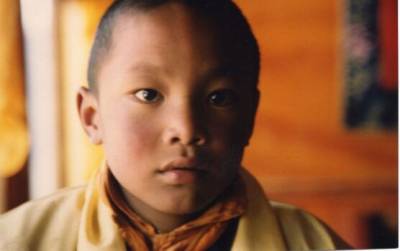
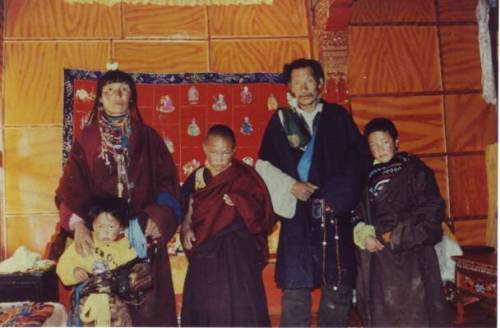
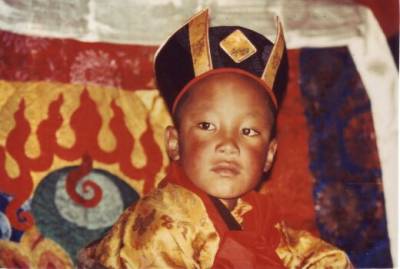
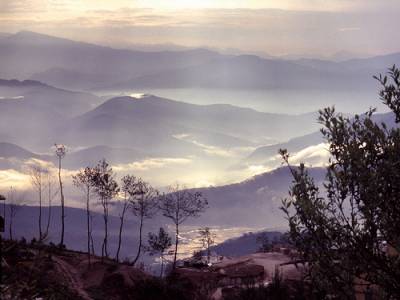
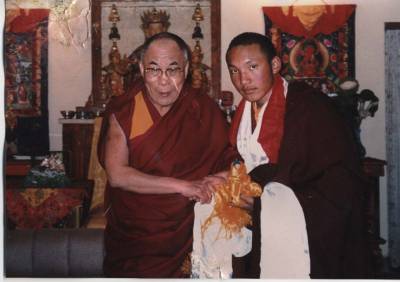
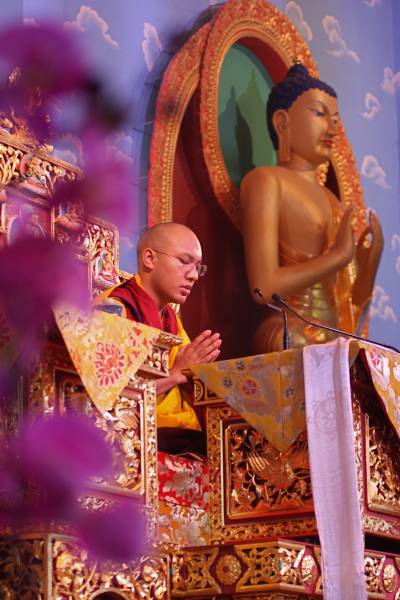
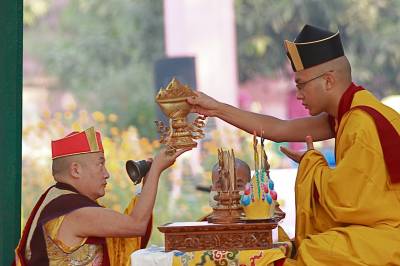
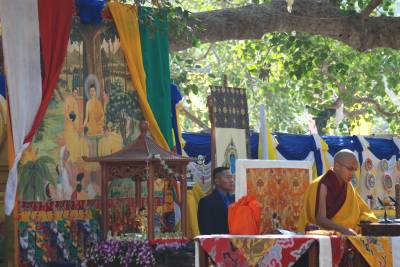
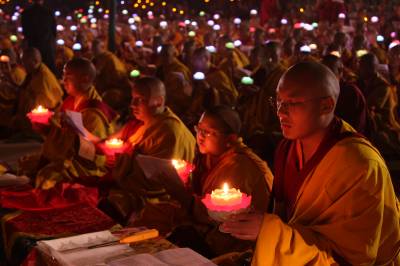
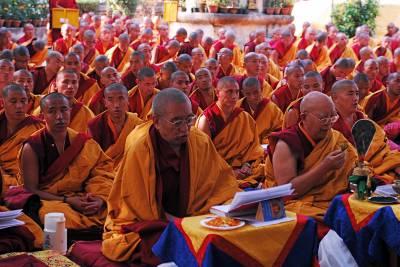
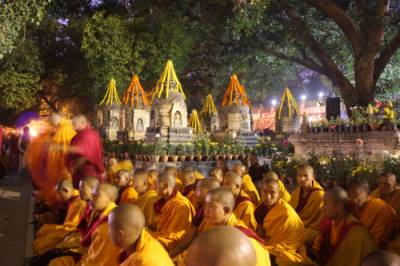
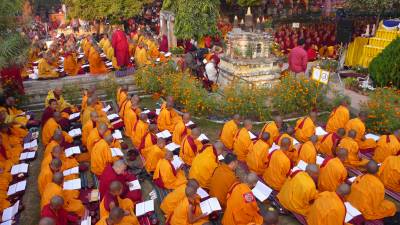
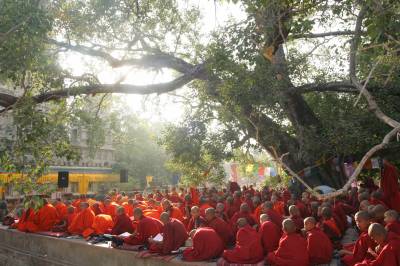
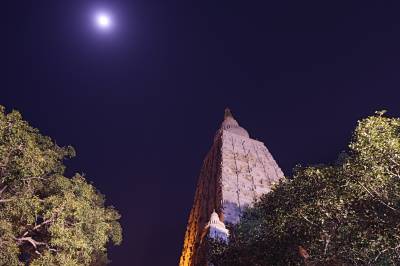
Explanation of a few photos:
- His Holiness the XVIIth Karmapa together with Venerable Chöje Lama Phuntsok in 2006.
- H.H. the XVIth Karmapa together with Situ Pema Wangchuk and high ranking Lamas at Palpung Monastery in Kham, Tibet, approximately 1940.
- H.H. the YVIIth Karmapa together with the H.E. Twelfth Tai Situ Rinpoche in Tibet.
- H.H. the XVIth Karmapa together with His Holiness the Dalai Lama in India in 1974.
- The hill station at Nagakot in Nepal.
- H.H. presiding over the Karma Guncho debates at Tergar Monastery in India, 2007.
- H.H. the XVIIth Karmapa receiving offering from H.E. Gyaltsap Rinpoche at the Great Kagyu Mönlam in Bodhgaya, India, Dec. 2007. - H.H. together with H.E. Jamgon Kongtrul Rinpoche the Fourth at the recent Kagyu Mönlam.
- Venerable Khenchen Thrangu Rinpoche and Venerable Tenga Rinpoche.
- The Great Mahabodhi Temple at Bodhgaya.
Dedication
Through this goodness, may omniscience be attained
And thereby may every enemy (mental defilement) be overcome.
May beings be liberated from the ocean of samsara
That is troubled by waves of birth, old age, sickness, and death.

May the life of the Glorious Lama remain steadfast and firm.
May peace and happiness fully arise for beings as limitless (in number) as space (is vast in its extent).
Having accumulated merit and purified negativities, may I and all living beings without exception swiftly establish the levels and grounds of Buddhahood.
Supplication for the Long Life of His Holiness Karmapa, Ogyen Trinley Dorje
Nirmanakaya of the Sixth Guide of this fortunate kalpa and of the Mahasiddha Saraha,
Seventeenth body of Düsum Khyenpa –
May Your lotus feet be stable and Your activity flourish.
You see, just as it is, the suchness of things to be known.
You kindly protect all beings.
Your energy is victorious over mara.
Karmapa, may Your lotus feet be stable and Your activity flourish.
The light of Your activity arising from the full mandala of the two accumulations
Illuminates the kunda grove of the Victor’s Doctrine.
You are the moon of sacred Dharmic proclamation.
May Your lotus feet be stable and Your activity flourish.
You are the preceptor of hundreds of thousands of renunciates, the father of millions of Bodhisattvas, and the Great Master of innumerable Vidyadharas.
May Your lotus feet be stable and Your activity flourish.
You raise the Doctrine’s Victory Banner in Jambudvipa.
The Banners of Your fame flutter everywhere.
Karmapa, Master of the Victors’ activity,
May Your lotus feet be stable and Your activity flourish.
Spreading the Lord of Sages’ Doctrine,
The Protector of beings in degenerate times is the manifestation of Lokeshvara.
Karmapa, may Your lotus feet be stable and Your activity flourish.
Through the intentions of the sacred Guru who is the Supreme Guide,
The truth of the undeceiving Three Jewels, and the interdependence of our pure, excellent wish,
May this aspiration be accomplished.
In accordance with the wishes of the Lord Protectors, the supreme Tai Situ Rinpoche and the supreme Gyaltsap Rinpoche, this aspiration was made by Ngawang Kunga of Drolma Podrang, the Throne Holder of the Glorious Sakyas, as an alternation of a previous composition. May this aspiration be accomplished!

The Song of His Holiness the Sixteenth Karmapa was translated under the guidance of Khenchen Thrangu Rinpoche by Michele Martin in April 1994; in: Website of Nalandabodhi in Seattle. The instructions by Venerable Chöje Lama Phuntsok were presented at Theksum Tashi Chöling in Hamburg in 2006. With sincere gratitude to Khenpo Karma Namgyal for many invaluable photos and for his immense help. Translated into English in reliance on the German rendering kindly offered by Dr. Klaus-Dieter Mathes by Gaby Hollmann, responsible for all mistakes. And special thanks to all members of the Dharma Centre in Hamburg for all they are doing. Copyright Karma Lekshey Ling Institute in Kathmandu, Nepal, and Theksum Tashi Chöling, 2008.

|